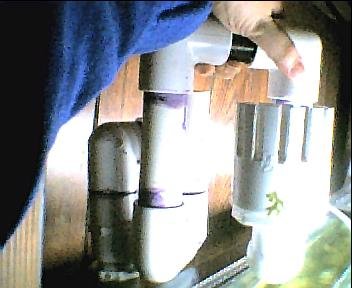yaksplat
Aquarium Advice Freak
I decided to install a sump into my stand and used the z-flow setup mentioned in this forum. It turns out that there are some unmentioned variables in the z-flow setup. The vacuum release hole size is very important in controlling waterflow. The height of the tee in relation to the water surface is also critical.
Vacuum release hole:
this is the hole in the cap that keeps the system primed and allows air to travel with the water into the sump. When a smaller hole is used, the flowrate increases drastically. Going from a 1/4" hole to a 1/16" increased the flow from about 110 to 500 gph. The reasoning for this is tendancy towards a true siphon all the way to the sump. The relative height is now 3 feet instead of 3 inches from the water surface to the water outlet. The greater the height differential, the greater the pressure drop, the higher the flow....up to the maximum for that diameter of pipe. You have to be careful that there is a high enough flow of water back into the tank though or else the overflow could suck air into the system and kill the siphon.
Tee Elevation:
The elevation of the tee will determine the level of the water that is in the overflow. Too high, and the flowrate will be very small. If it is too low, the overflow will pull air into the system. Preferably you will want the bottom of the horizontal portion of the tee to be at least an inch above the lowest elbow inside the tank and also about 3" below the water surface. Which is roughly 2.5" below the surface of the overflow cup.
Combing this knowledge with the post by BillyZ should result in a good functioning Z-flow with no problems. Being on the careful side, I'm in the process of installing a floatswitch in the tank that will shut off the main pump if the waterlevel gets too high.
Jim
Vacuum release hole:
this is the hole in the cap that keeps the system primed and allows air to travel with the water into the sump. When a smaller hole is used, the flowrate increases drastically. Going from a 1/4" hole to a 1/16" increased the flow from about 110 to 500 gph. The reasoning for this is tendancy towards a true siphon all the way to the sump. The relative height is now 3 feet instead of 3 inches from the water surface to the water outlet. The greater the height differential, the greater the pressure drop, the higher the flow....up to the maximum for that diameter of pipe. You have to be careful that there is a high enough flow of water back into the tank though or else the overflow could suck air into the system and kill the siphon.
Tee Elevation:
The elevation of the tee will determine the level of the water that is in the overflow. Too high, and the flowrate will be very small. If it is too low, the overflow will pull air into the system. Preferably you will want the bottom of the horizontal portion of the tee to be at least an inch above the lowest elbow inside the tank and also about 3" below the water surface. Which is roughly 2.5" below the surface of the overflow cup.
Combing this knowledge with the post by BillyZ should result in a good functioning Z-flow with no problems. Being on the careful side, I'm in the process of installing a floatswitch in the tank that will shut off the main pump if the waterlevel gets too high.
Jim

